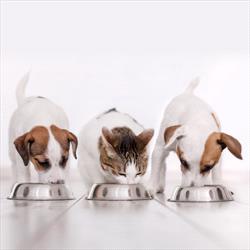You’ve spoken with your veterinarian and are thinking about personally making your pet’s meals. There are about as many diet options for your pet as there are for you, so which one is best? Breed, age, weight, allergies, medical conditions, and finances are some of the contributing factors that need to be considered when choosing an alternative diet.
Dog and Cat Eating

Photo courtesy of Depositphotos
If you decide to home cook your pet’s food, we highly recommend first consulting with a veterinary nutritionist to ensure that your pet’s nutritional needs are adequately met. Once there is a recipe available, it is important to follow it exactly. Any changes could affect its nutritional value.
Sometimes, especially in the case of dietary adverse responses, your veterinarian may recommend a limited ingredient home-cooked diet. The purpose is to identify those foods to which your pet is sensitive; there will be trial and error. When discussing your pet’s diet history with your veterinarian, be as thorough as possible to shorten the time that your pet has to be on a limited-ingredient diet. During this period, do not give anything outside of the specific diet or the results will not be accurate.
When purchasing foods and/or ingredients, look at the nutrition label, just as you do for your own food. “Organic” is a USDA certification that refers to how a food is grown and processed. For example, organic vegetables may be grown without pesticides and organic meats may come from animals that were allowed to graze or are antibiotic/hormone free. “Natural” products are those without synthetic ingredients, added coloring, and often are minimally processed.
A common misconception is that corn is a filler and causes significant allergies in pets. However, a study was done in 2016 on 297 dogs. Of those, only about four percent had a corn allergy. Corn is a source of carbohydrates, proteins, vitamins, minerals, fiber, and fats. Corn provides energy and helps digestion and in most cases is completely fine for dogs to eat.
“Grain-free” means that the product does not include grains such as rice, corn, or wheat. Therefore, the source of carbohydrates are peas, legumes, potatoes and/or lentils. Grain-free diets and their possible association with dilated cardiomyopathy (DCM) are continuously being researched. Caution is advised at this time before making any choices about grain-free diets.
Gluten is the protein in grain that is left over after all the starch is removed. Celiac disease is an intolerance to gluten. Celiac disease in dogs is incredibly rare (as it is in people) and has not been documented in cats as of November 2019. Dogs reported to have celiac disease were mainly from a single line of inbred Irish Setters in the United Kingdom. Unless your dog has a known sensitivity to gluten, there is no need to avoid it in their diet.
Raw pet food is commonly either frozen or freeze-dried. Prepackaged raw diets that are not marked as complete may need to have vitamin and mineral supplements added to provide a balanced meal. Do not exclude the parts of the meal that your pet selectively ignores, as this can also lead to deficiencies and subsequent clinical disease; make sure, one way or another, that the pet eats all of it. Nutrient deficiencies can occur if a meal is not made correctly. Bones can potentially cause obstructions, constipation, and tooth fractures. A real risk of feeding raw food is bacterial contamination, especially by Salmonella and E. coli. Contamination can affect your pets, healthy humans, and can be devastatingly harmful to pregnant, young, old, or immunocompromised people in the house. Raw diets also increase the risk of exposure to parasites. Raw feeding is not recommended according to the official AVMA position, which strongly discourages raw feeding.
Some veterinarians recommend that cats be able to eat various foods, including non-dry, non-kibble food to provide moisture in their diets. If your feline arrives to your home as a kitten, make sure to feed a variety of foods and textures as kittens will imprint on what they were fed as kittens. If your feline arrives as an adult, do your best to encourage a variety of foods. For some medical conditions, feeding an all-canned diet may be recommended.
Although raw feeding is not recommended, if you have made the decision to feed a raw or alternative diet, it is time to hit the store! A great way to make consistent meals for your pet is to print and laminate instructions from your veterinarian and veterinary nutritionist. You can purchase a cutting board and bowls/plates that are specifically for your furry friend’s food to lower the risk of cross-contamination. Many people find they can reduce their costs by purchasing large quantities of each ingredient and storing the meat in a freezer purchased specifically for pet food. Some butchers understand the needs of pet owners, and you may be able to arrange with them to have the best possible price. Dedicate a part of your pantry and fridge to ingredients specifically for your pet; Your pet will thank you!